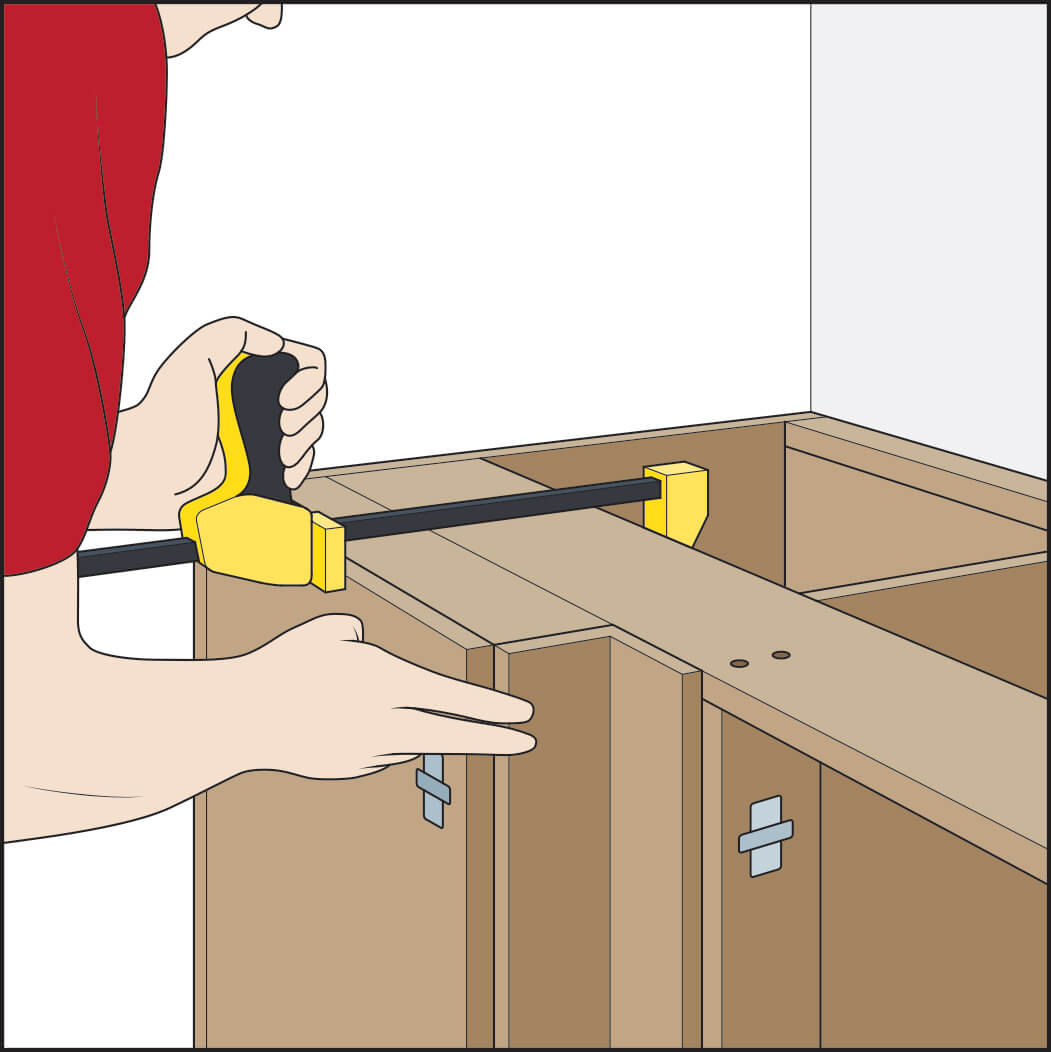How To Fit A Kitchen Corner Post In 4 Easy Steps
Once you have decided on the type of corner post you need and understood how corner posts are set up, the installation becomes a straightforward process for any keen DIY'er.
After the corner post has been installed, you can move on to installing the rest of your kitchen units!
Getting ready
Our adjustable corner posts are supplied in two pieces made of door-matching material, while Fixed Posts come as a single piece. An additional MFC section comes with the corner unit itself.
Once the corner unit and the adjacent unit are squared and secured to the walls, follow these instructions:
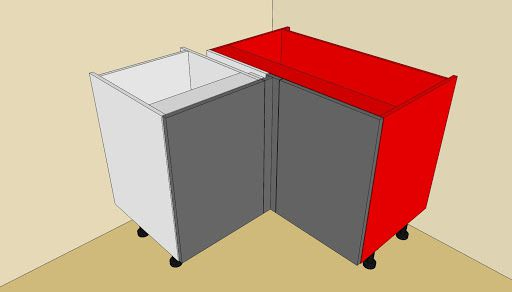
Step 1:
Locate your Corner Post items and remove the small MFC panel (we'll call this Part 3) from the corner unit by releasing the two screws at the top and bottom of the panel.
Remove the packaging from the Corner Post and attach Corner Post Panel 1 in the original position, replacing the now-removed small MFC panel on the Corner Unit.
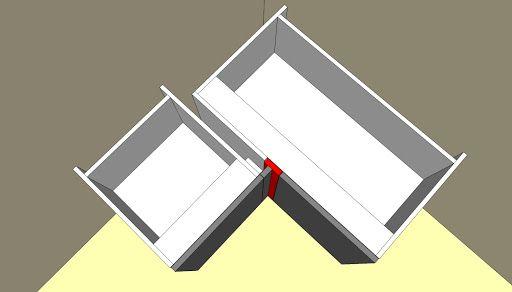
Step 2:
Determine the required size of Corner Post Part 2 by measuring the gap between Part 1 and the adjacent unit, then cut to size.
After marking the location of Part 2, remove Part 1 from the cabinet and secure Part 2 to Part 1 in the correct position using appropriate screws (not supplied).
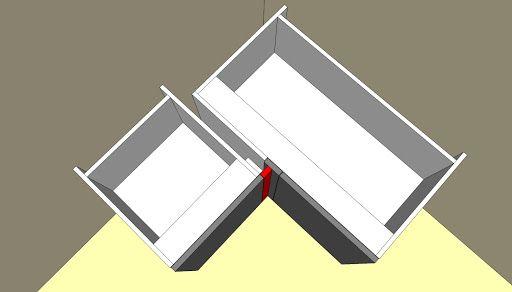
Step 3:
Connect Part 3 to the leading edge of Part 2 using angle brackets or a block of timber (not supplied).
Ensure there's an even gap at the top and bottom of Part 2. You'll notice that Parts 1 & 2 are slightly shorter than Part 3. This design ensures the corner post aligns correctly with the door edges.
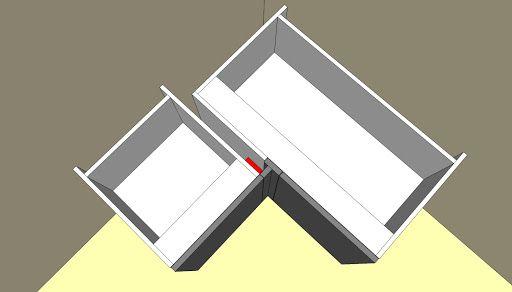
Step 4:
Slide the finished corner post into the correct position and tighten the screws on Part 1.
Now, align the top and front edge of Corner Post Part 3 with the adjacent unit and attach it using appropriate screws from the inside of the unit.
These screws can often be concealed behind the screw hinge plates and drawer runners for a neater finish.
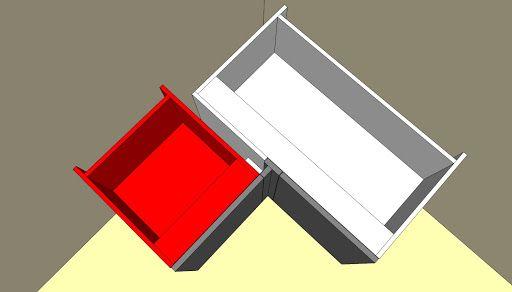
Understanding Corner Posts in Kitchen Cabinetry
Corner posts play a pivotal role in the design and functionality of kitchen cabinetry, serving as the cornerstone for ensuring that the cabinetry not only looks cohesive but also functions seamlessly. This article delves into the nuances of corner posts, highlighting their significance in kitchen aesthetics and usability.
The Basics of Corner Posts
Corner posts are integral components of kitchen cabinetry, designed to reinforce and beautify the juncture where two cabinets meet at a corner. Choosing the correct type of corner post is essential for achieving both an appealing design and a practical kitchen layout.
Types of Corner Posts
The world of kitchen design introduces us to two primary types of corner posts: fixed and adjustable. Each serves a unique purpose, catering to various design needs and preferences.
Fixed Corner Posts
Description and Standard Dimensions:
Fixed corner posts are non-adjustable, rigid supports typically measuring 60mm by 60mm or 70mm by 70mm. They ensure that cabinet doors align properly, preventing interference when opened.
Pros and Cons:
Fixed corner posts offer a seamless and clean look but lack flexibility in terms of spacing and adjustment.
Ideal Use Cases:
These posts are perfect for standard kitchen layouts where cabinet dimensions do not require customization.
Installation Considerations:
Installing fixed corner posts requires precise measurement to ensure they fit perfectly without the need for adjustment.
Adjustable Corner Posts
Description and Adjustability:
Adjustable corner posts feature a design that can be tailored to fit various dimensions, creating an L-shaped piece that accommodates different kitchen layouts.
Range of Dimensions:
These posts can be adjusted to widths ranging from 50mm to 2500mm, with a standard height of 720mm, suitable for both plain and handleless door designs.
Pros and Cons:
Adjustable corner posts provide unmatched flexibility but may require more effort in terms of installation and adjustment.
Ideal Use Cases:
These posts are ideal for custom or irregularly shaped kitchens where standard dimensions do not suffice.
Installation Tips:
Adjustable corner posts necessitate careful planning and measurement to ensure they fit the intended space perfectly.
Comparing Fixed and Adjustable Corner Posts
| Feature | Fixed Corner Posts | Adjustable Corner Posts |
|---|---|---|
| Flexibility | Low | High |
| Installation Ease | Moderate to High | Moderate |
| Customisation | Limited | Extensive |
| Aesthetic | Seamless | Customisable |
Design Considerations
The choice of corner post significantly impacts the kitchen's overall appearance. Whether opting for a plain panel or a handleless design, the corner post should complement the cabinetry style, ensuring a harmonious look.
Practical Considerations
Functionality, ease of access, and space utilisation are crucial aspects to consider. Maintenance and durability also play a significant role in the selection process.
Installation Tips
Proper installation is key to the longevity and effectiveness of corner posts. It's advisable to follow best practices and address common challenges proactively.
Decision-Making Guide
Before settling on a corner post, consider the following:
- What is the layout of the kitchen?
- Does the design require flexibility?
- How will the corner post complement the overall kitchen aesthetic?
Choosing the right type of corner post is a balance between aesthetic appeal and practical functionality. By considering the aspects highlighted in this article, you can make an informed decision that enhances the beauty and usability of your kitchen.
FAQs on Kitchen Corner Posts
Understanding kitchen updates can be tricky, particularly with phrases such as 'kitchen unit corner post' and 'kitchen base unit corner post'. Rest assured, we've gathered a list of commonly asked questions to make it clearer for you.
What is a kitchen corner post?
A kitchen corner post is a piece of material, often matching the kitchen units, that sits between two cabinets, ensuring they align perfectly, especially at corners.
Why is kitchen corner post fitting essential?
Fitting a kitchen corner post ensures that there's a seamless transition between kitchen units, enhancing both functionality and aesthetics.
How does a corner post kitchen design differ from a regular one?
A corner post kitchen design incorporates posts at the junctions of cabinets, ensuring a smooth and aligned finish, unlike regular designs that might have gaps or misalignments.
What's the difference between a kitchen unit corner post and a kitchen base unit corner post?
While both serve the same purpose, a kitchen unit corner post is a general term, whereas a kitchen base unit corner post specifically refers to the posts used at the base or bottom cabinets.
Can I refer to Howdens corner post fitting instructions for other brands?
While the basic concept might be similar, it's best to refer to brand-specific instructions to ensure proper fitting and alignment.
Is kitchen corner fitting different from fitting other parts of the kitchen?
Yes, kitchen corner fitting requires precision to ensure that the cabinets align perfectly at the corners, which might not be as crucial for other parts.
Can I customise my kitchen cabinet corner post?
Absolutely! Many brands and carpenters offer customisation options to match your kitchen's design and aesthetics.
Are there any alternatives to using a kitchen corner post?
While corner posts are the most common solution, some designs incorporate corner drawers or pull-out solutions. However, for a classic look and feel, corner posts are preferred.
Conclusion
Kitchen corner posts play a pivotal role in ensuring your kitchen looks sleek and functions efficiently.
Whether you're renovating or building a diy kitchen from scratch, understanding the nuances of kitchen corner posts can make a world of difference. Always refer to specific brand guidelines, be it Better Kitchens, B&Q or Howdens, for the best results.

